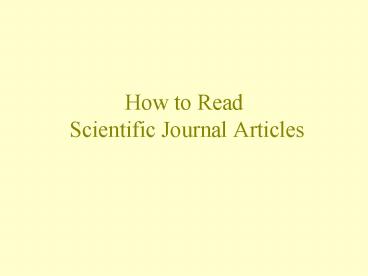How to Read Scientific Journal Articles PowerPoint PPT Presentation
1 / 12
Title: How to Read Scientific Journal Articles
1
How to Read Scientific Journal Articles
2
Major article sections
- Abstract -- brief summary of entire article
- Introduction -- includes literature review
states why the research is relevant. - Methods -- identifies how patients were selected,
what study procedures entailed, and statistical
methods used. - Results -- presents objective results
- Discussion -- interprets results states study
strengths/weaknesses identifies future work
3
What population(s)?
- The study eligibility criteria define the
characteristics of the patients studied, and
therefore the population(s) to which the results
can be extended. - The baseline characteristics define the
characteristics of the patients studied, and
therefore the population(s) to which the results
can be extended. (Often, Table I.)
4
Identification of groups
- Typically, one group is considered a control
group, while other groups are considered new
treatment groups. - The groups should be similar, on average, except
with respect to the primary treatment(s) of
interest. (Often, Table I.) - Ideally, groups will be created by randomly
assigning individuals to groups.
5
With respect to what are the groups being
compared?
- The main variables by which the groups are
compared are called the primary outcome measures. - A good study is designed with the primary outcome
measures in mind. - The less important variables by which the groups
are compared are called the secondary outcome
measures.
6
How are outcome measures be analyzed
statistically?
- The type of data and how the study was designed
determine the appropriate analysis methods. - Categorical (binary) data are often summarized as
percentages, but also odds ratios and relative
risks. - Numerical (measurement) data are often summarized
as means, but also medians.
7
Presentation of results
- Statistical results can be presented in words or
in a table. - If a summary measure, like a percentage or a
mean, is reported without a P-value or a
confidence interval, the result only applies to
the sample of patients in the study.
8
Presentation of P-values
- In a table, P-values are usually indicated by a
footnote. - In writing, P-values are usually indicated in
parentheses after the conclusion of a hypothesis
test is stated. - It is the readers job to infer the null and
alternative hypotheses of the hypothesis test.
9
Presentation of confidence intervals
- Confidence intervals for a mean are typically
presented in one of three ways. - Sample mean SD, (standard deviation)
- Sample mean SE (standard error)
- The lower and upper limits of the interval
- If Sample mean SD, the 95 margin of error is
2(SDsqrt(n)) - If Sample mean SE, the 95 margin of error is
2SE.
10
Presentation of confidence intervals
- It is the readers job to know what value is
relevant to the confidence interval - If a confidence interval for a difference in two
means or a confidence interval for a difference
in two proportions, then is 0 in the interval? - If a confidence interval for a relative risk, or
a confidence interval for an odds ratio, then is
1 in the interval? - And so on ...
11
Evaluation of the strengths/weaknesses of the
study
- Is there a control group?
- Is the study a randomized experiment or an
observational study? - Were the patients selected and assigned to their
treatments in an unbiased manner? - Were the patients and physicians blinded to
treatment assignment?
12
Evaluation of the strengths/weaknesses of the
study
- Was the sample large enough to get useful
statistical results? - If the sample was really large, were confidence
intervals created to show that a rejection of the
null hypothesis is actually meaningful? - Are the conclusions of the study overstated?
- Do the authors point out future necessary
research?

